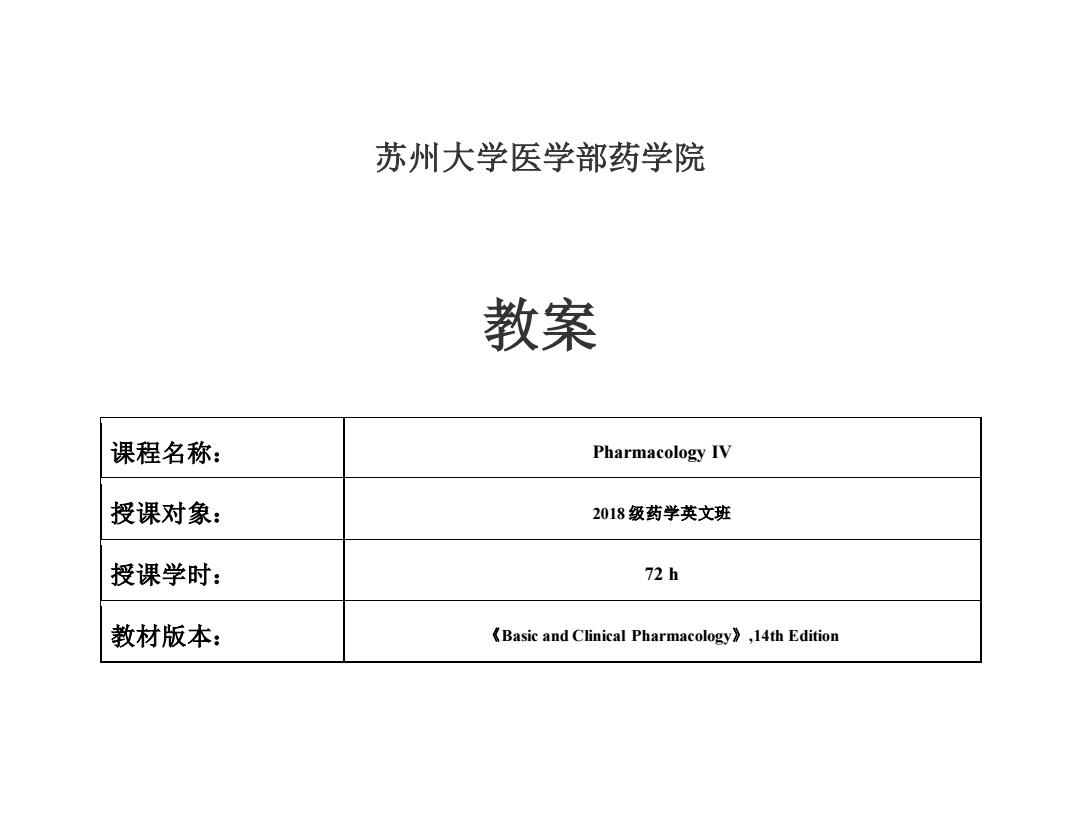
苏州大学医学部药学院 教案 课程名称: Pharmacology IV 授课对象: 2018级药学英文班 授课学时: 72h 教材版本: Basic and Clinical Pharmacology>,14th Edition
苏州大学医学部药学院 教案 课程名称: Pharmacology IV 授课对象: 2018 级药学英文班 授课学时: 72 h 教材版本: 《Basic and Clinical Pharmacology》,14th Edition
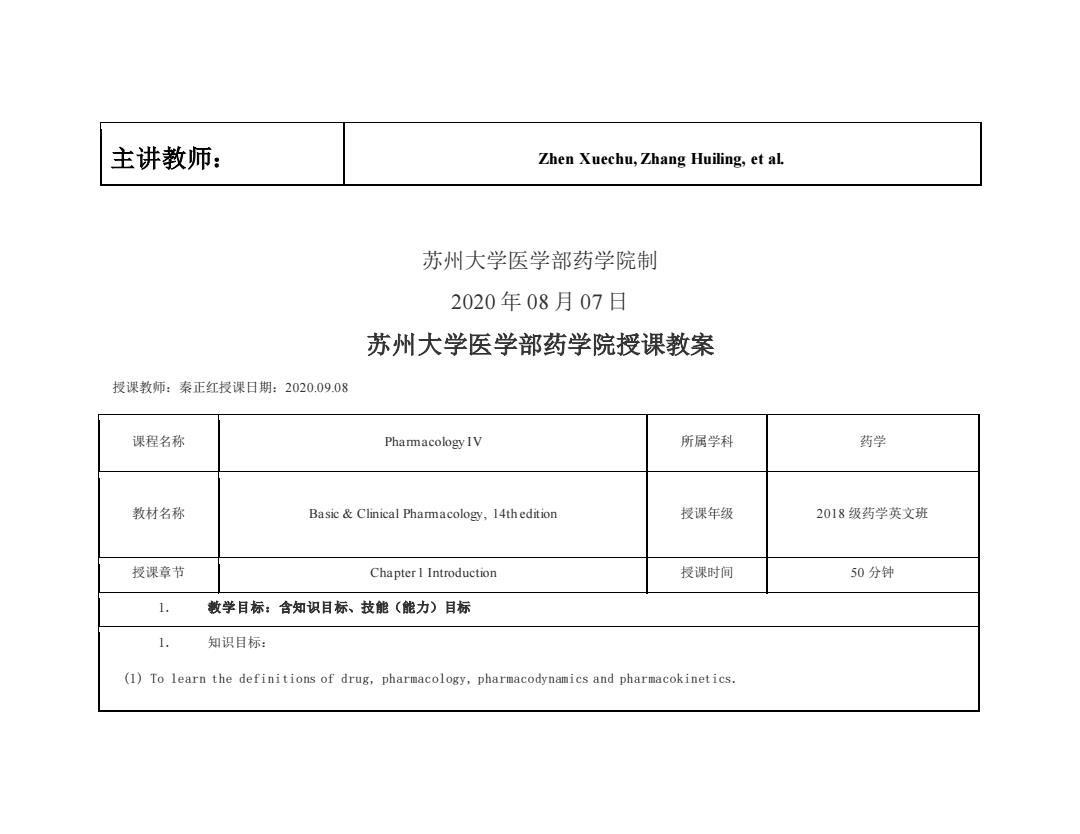
主讲教师: Zhen Xuechu,Zhang Huiling,et al. 苏州大学医学部药学院制 2020年08月07日 苏州大学医学部药学院授课教案 授课教师:秦正红授课日期:2020.09.08 课程名称 Pharacology IV 所属学科 药学 教材名称 Basic Clinical Pharmacology,14thedition 授课年级 2018级药学英文班 授课章节 ChapterI Introduction 授课时间 50分钟 1. 教学目标:含知识目标、技能(能力)目标 1. 知识目标: (1)To learn the definitions of drug,pharmacology,pharmacodynamics and pharmacokinetics
主讲教师: Zhen Xuechu, Zhang Huiling, et al. 苏州大学医学部药学院制 2020 年 08 月 07 日 苏州大学医学部药学院授课教案 授课教师:秦正红授课日期:2020.09.08 课程名称 Pharmacology IV 所属学科 药学 教材名称 Basic & Clinical Pharmacology, 14th edition 授课年级 2018 级药学英文班 授课章节 Chapter 1 Introduction 授课时间 50 分钟 1. 教学目标:含知识目标、技能(能力)目标 1. 知识目标: (1) To learn the definitions of drug, pharmacology, pharmacodynamics and pharmacokinetics
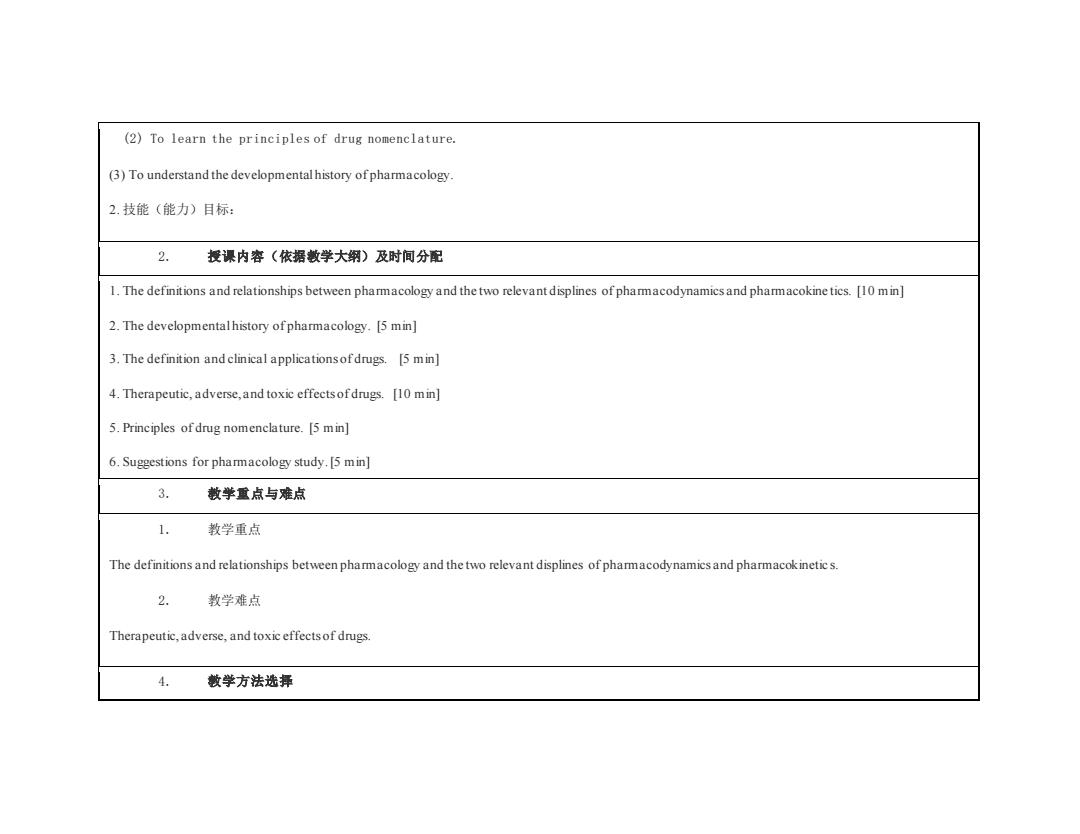
(2)To learn the principles of drug nomenclature. (3)To understand the developmentalhistory ofpharmacology. 2.技能(能力)目标: 2. 授课内容(依据教学大细)及时间分配 1.The definitions and relationships between pharmacology and the two relevant displines of pharmacodynamicsand pharmacokine tics.[10 min] 2.The developmentalhistory ofpharmacology.[5 min] 3.The definition and clinical applicationsofdrugs.[5 min] 4.Therapeutic,adverse,and toxic effectsofdrugs.[10 min] 5.Principles of drug nomenclature.[5 min] 6.Suggestions for pharmacology study.[5 min] 3. 教学重点与难点 1. 教学重点 The definitions and relationships between pharmacology and the two relevant displines of pharmacodynamics and pharmacokinetic s. 教学难点 Therapeutic,adverse,and toxic effectsof drugs. 4. 教学方法选择
(2) To learn the principles of drug nomenclature. (3) To understand the developmental history of pharmacology. 2. 技能(能力)目标: 2. 授课内容(依据教学大纲)及时间分配 1. The definitions and relationships between pharmacology and the two relevant displines of pharmacodynamics and pharmacokine tics. [10 min] 2. The developmental history of pharmacology. [5 min] 3. The definition and clinical applications of drugs. [5 min] 4. Therapeutic, adverse, and toxic effects of drugs. [10 min] 5. Principles of drug nomenclature. [5 min] 6. Suggestions for pharmacology study. [5 min] 3. 教学重点与难点 1. 教学重点 The definitions and relationships between pharmacology and the two relevant displines of pharmacodynamics and pharmacokinetic s. 2. 教学难点 Therapeutic, adverse, and toxic effects of drugs. 4. 教学方法选择
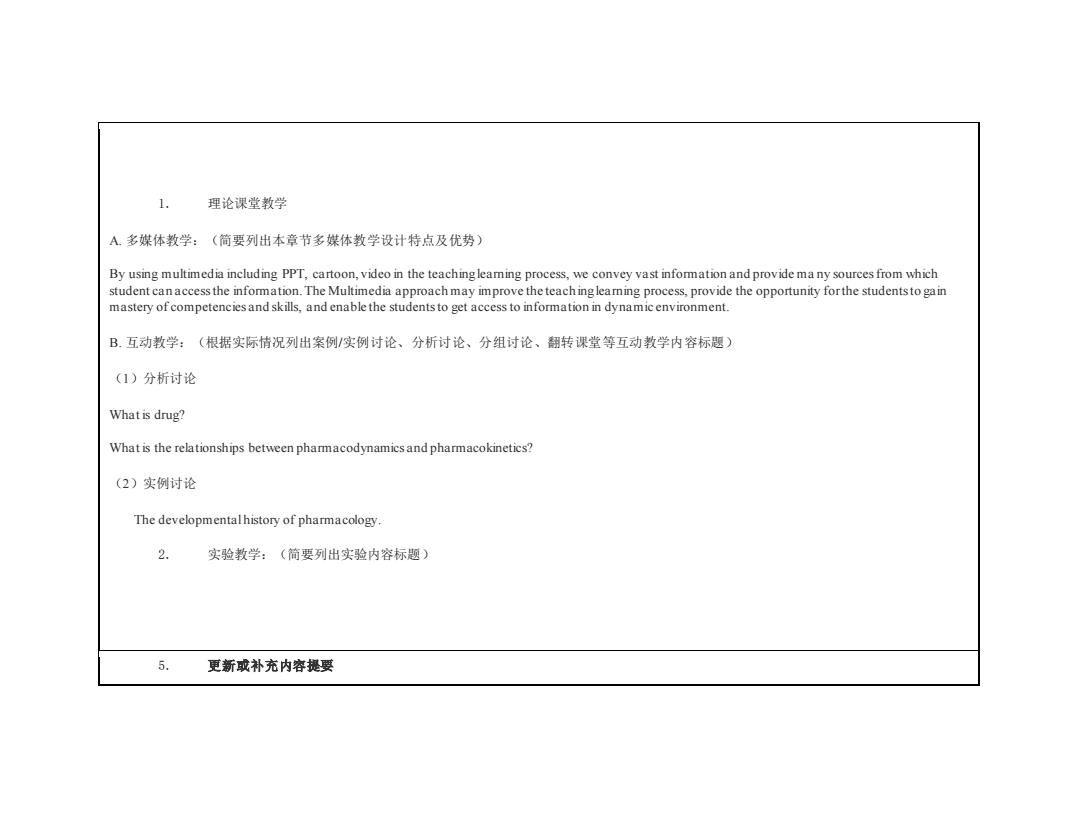
1. 理论课堂教学 A多媒体教学:(简要列出本章节多媒体教学设计特点及优势) By using multimedia including PPT,cartoon,video in the teachingleaming process,we convey vast information and provide ma ny sources from which student canaccess the information.The Multimedia approach may improve the teaching leaming process,provide the opportunity forthe studentsto gain mastery of competencies and skills,and enable the students to get access to information in dynamic environment. B.互动教学:(根据实际情况列出案例/实例讨论、分析讨论、分组讨论、翻转课堂等互动教学内容标题) (1)分析讨论 What is drug? What is the relationships between pharmacodynamics and pharmacokinetics? (2)实例讨论 The developmentalhistory of pharmacology. 2. 实验教学:(简要列出实验内容标题) 5. 更新或补充内容提要
1. 理论课堂教学 A. 多媒体教学:(简要列出本章节多媒体教学设计特点及优势) By using multimedia including PPT, cartoon, video in the teaching learning process, we convey vast information and provide ma ny sources from which student can access the information. The Multimedia approach may improve the teach ing learning process, provide the opportunity for the students to gain mastery of competencies and skills, and enable the students to get access to information in dynamic environment. B. 互动教学:(根据实际情况列出案例/实例讨论、分析讨论、分组讨论、翻转课堂等互动教学内容标题) (1)分析讨论 What is drug? What is the relationships between pharmacodynamics and pharmacokinetics? (2)实例讨论 The developmental history of pharmacology. 2. 实验教学:(简要列出实验内容标题) 5. 更新或补充内容提要

6. 复习思考趣 1.The relationships between pharmacodynamicsand pharmacokinetics. 2.The developmentalhistory ofpharmacology. 7. 学习资源、课外自主学习参考 (可以列出供学生进一步学习、拓展本章节内容的网站、著作、期刊的名称及内容等) 朱依谆主编.药理学第八版,北京,人民卫生出版社,2019 Oxford Textbook of Clinical Pharmacology and Drug Therapy David Grahame-Smith,Jeffrey Aronson.Edition:3 Clinical Pharmacology Made Incredibly Easy!(Incredibly Easy!Series) Springhouse,2008 Edition:3Rev Ed. 苏州大学医学部药学院授课教案 授课教师:秦正红授课日期:2020.09.09
6. 复习思考题 1. The relationships between pharmacodynamics and pharmacokinetics. 2. The developmental history of pharmacology. 7. 学习资源、课外自主学习参考 (可以列出供学生进一步学习、拓展本章节内容的网站、著作、期刊的名称及内容等) 朱依谆主编. 药理学第八版, 北京, 人民卫生出版社, 2019 Oxford Textbook of Clinical Pharmacology and Drug Therapy David Grahame-Smith , Jeffrey Aronson. Edition: 3 Clinical Pharmacology Made Incredibly Easy! (Incredibly Easy! Series) Springhouse , 2008 Edition: 3Rev Ed. 苏州大学医学部药学院授课教案 授课教师:秦正红授课日期:2020.09.09
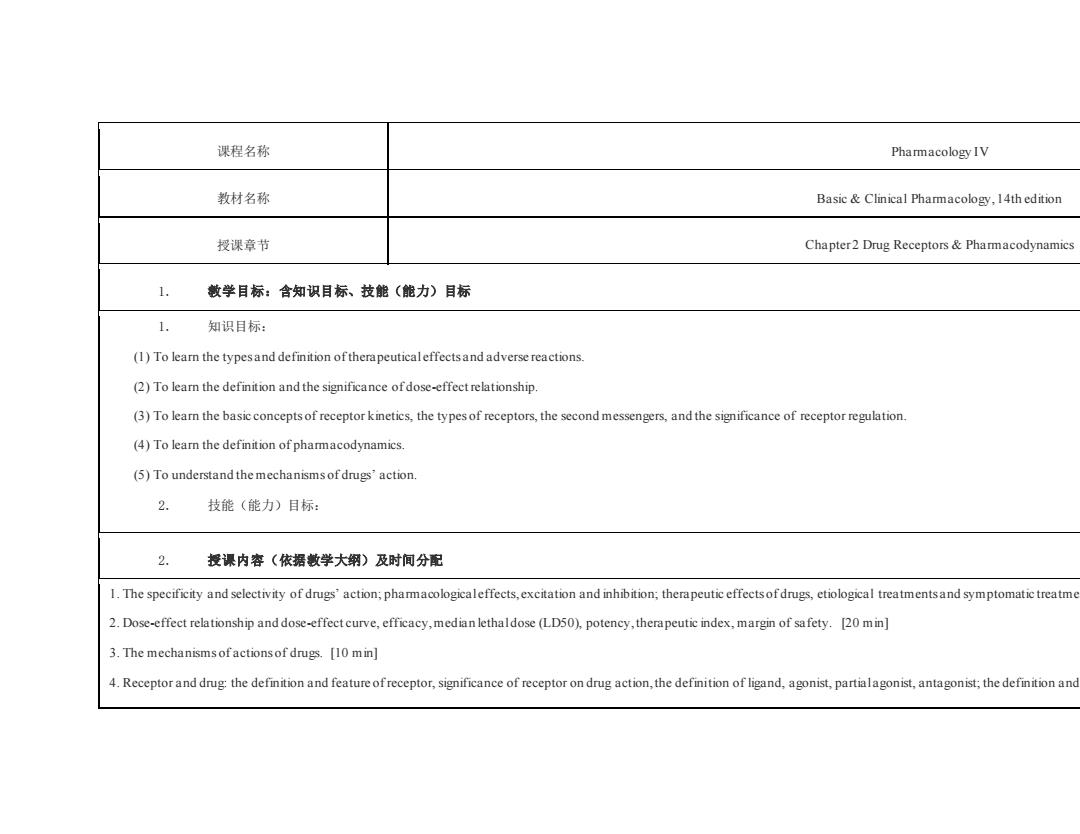
课程名称 Pharmacology IV 教材名称 Basic Clinical Pharmacology,14th edition 授课章节 Chapter2 Drug Receptors Pharmacodynamics 1. 敦学目标:含知识目标、技能(能力)目标 1. 知识目标: (1)To learn the typesand definition oftherapeuticaleffectsand adverse reactions. (2)To learn the definition and the significance ofdose-effect relationship. (3)To learn the basic concepts of receptor kinetics,the types of receptors,the second messengers,and the significance of receptor regulation. (4)To learn the definition of pharmacodynamics. (5)To understand the mechanisms of drugs'action. 2. 技能(能力)目标: 2. 授课内容(依据教学大细)及时间分配 I.The specificity and selectivity of drugs'action;pharmacologicaleffects,excitation and inhibition;therapeutic effectsofdrugs,etiological treatmentsand symptomatic treatme 2.Dose-effect relationship and dose-effect curve,efficacy,median lethaldose(LD50),potency,therapeutic index,margin of safety.[20 min] 3.The mechanisms of actionsof drugs.[10 min] 4.Receptor and drug:the definition and feature ofreceptor,significance of receptor on drug action,the definition of ligand,agonist,partialagonist,antagonist;the definition and
课程名称 Pharmacology IV 教材名称 Basic & Clinical Pharmacology, 14th edition 授课章节 Chapter 2 Drug Receptors & Pharmacodynamics 1. 教学目标:含知识目标、技能(能力)目标 1. 知识目标: (1) To learn the types and definition of therapeutical effects and adverse reactions. (2) To learn the definition and the significance of dose-effect relationship. (3) To learn the basic concepts of receptor kinetics, the types of receptors, the second messengers, and the significance of receptor regulation. (4) To learn the definition of pharmacodynamics. (5) To understand the mechanisms of drugs’ action. 2. 技能(能力)目标: 2. 授课内容(依据教学大纲)及时间分配 1. The specificity and selectivity of drugs’ action; pharmacological effects, excitation and inhibition; therapeutic effects of drugs, etiological treatments and symptomatic treatments; adverse reactions, side reac tions, toxic effects, withdrawal effects and allergic reactions. [20 min] 2. Dose-effect relationship and dose-effect curve, efficacy, median lethal dose (LD50), potency, therapeutic index, margin of safety. [20 min] 3. The mechanisms of actions of drugs. [10 min] 4. Receptor and drug: the definition and feature of receptor, significance of receptor on drug action, the definition of ligand, agonist, partial agonist, antagonist; the definition and characteristics of competitive antagonist and non -competitive antagonist; affinity, intrinsic activity, the types of receptors, the definition and types of the second messenge rs, receptor desensitization. [15 min]
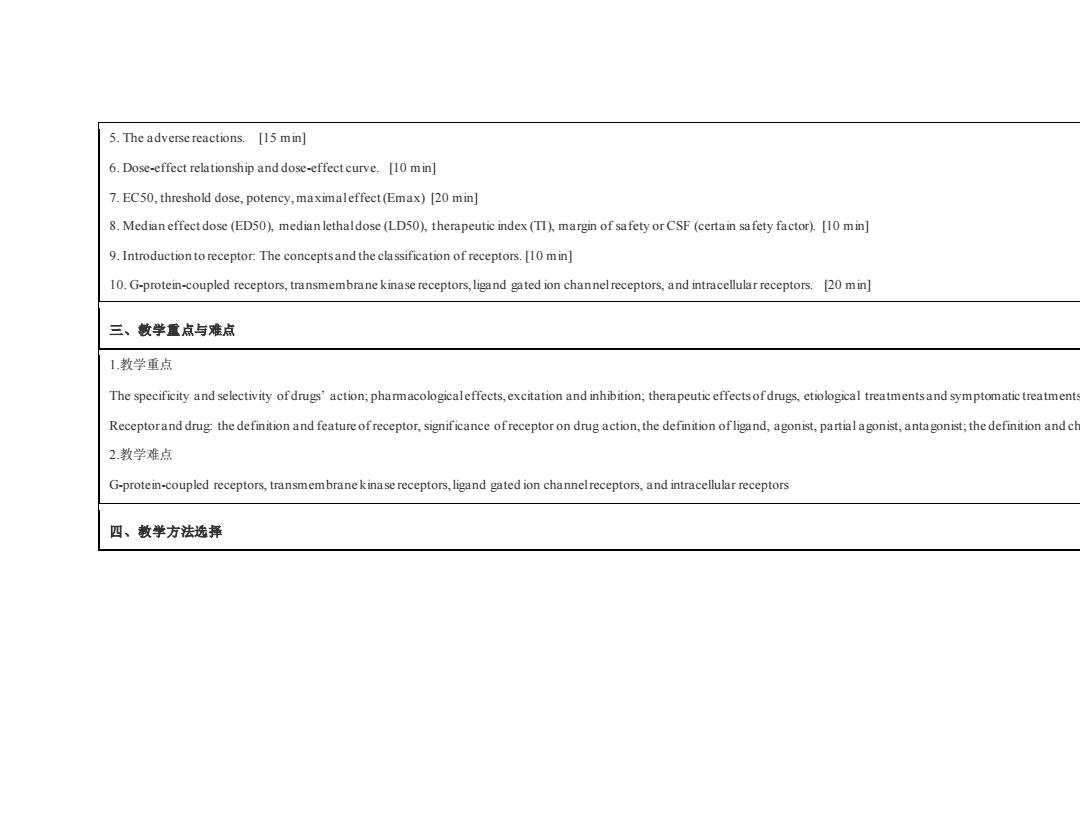
5.The adverse reactions.[15 min] 6.Dose-effect relationship and dose-effect curve.[10 min] 7.EC50,threshold dose,potency,maximaleffect(Emax)[20 min] 8.Median effect dose(ED50),median lethaldose(LD50),therapeutic index (TI),margin of safety or CSF (certain safety factor).[10 min] 9.Introductionto receptor.The conceptsand the classification of receptors.[10 min] 10.G-protein-coupled receptors,transmembrane kinase receptors,ligand gated ion channel receptors,and intracellular receptors.[20 min] 三、敦学重点与难点 1.教学重点 The specificity and selectivity ofdrugs'action;pharmacologicaleffects,excitation and inhibition;therapeutic effects of drugs,etiological treatments and symptomatic treatments Receptorand drug the definition and feature ofreceptor,significance ofreceptor on drug action,the definition of ligand,agonist,partial agonist,antagonist;the definition and ch 2.教学难点 G-protein-coupled receptors,transmembrane kinase receptors,ligand gated ion channelreceptors,and intracellular receptors 四、教学方法选择
5. The adverse reactions. [15 min] 6. Dose-effect relationship and dose-effect curve. [10 min] 7. EC50, threshold dose, potency, maximal effect (Emax) [20 min] 8. Median effect dose (ED50), median lethal dose (LD50), therapeutic index (TI), margin of safety or CSF (certain safety factor). [10 min] 9. Introduction to receptor: The concepts and the classification of receptors. [10 min] 10. G-protein-coupled receptors, transmembrane kinase receptors, ligand gated ion channel receptors, and intracellular receptors. [20 min] 三、教学重点与难点 1.教学重点 The specificity and selectivity of drugs’ action; pharmacological effects, excitation and inhibition; therapeutic effects of drugs, etiological treatments and symptomatic treatments; adverse reactions, side reac tions, toxic effects, withdrawal effects and allergic reactions. Receptor and drug: the definition and feature of receptor, significance of receptor on drug action, the definition of ligand, agonist, partial agonist, antagonist; the definition and charact eristics of competitive antagonist and non-competitive antagonist; affinity, intrinsic activity, the types of receptors, the definition and types of the second messengers, receptor desensitization. 2.教学难点 G-protein-coupled receptors, transmembrane kinase receptors, ligand gated ion channel receptors, and intracellular receptors 四、教学方法选择
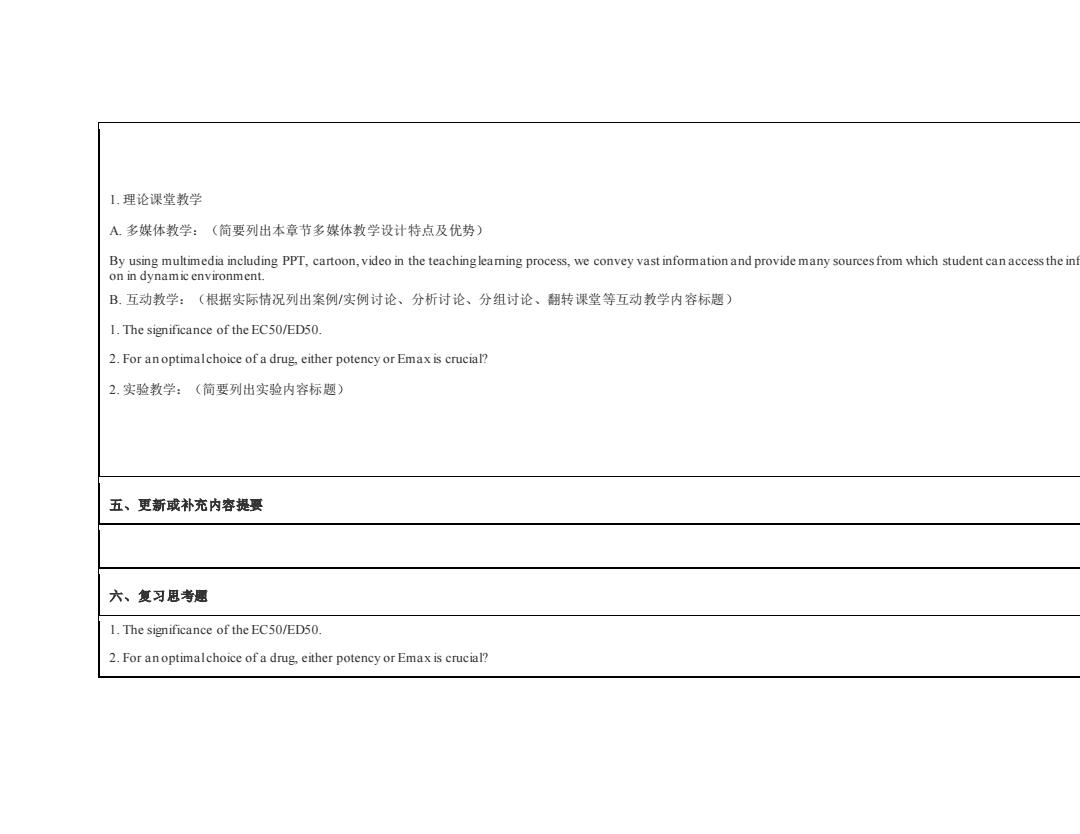
L理论课堂教学 A多媒体教学:(简要列出本章节多媒体教学设计特点及优势) By using multimedia including PPT,cartoon,video in the teachingleaming process,we convey vast information and provide many sources from which student can access the inf on in dynamic environment. B.互动教学:(根据实际情况列出案例/实例讨论、分析讨论、分组讨论、翻转课堂等互动教学内容标题) 1.The significance of the EC50/ED50. 2.For anoptimalchoice of a drug,either potency or Emax is crucial? 2.实验教学:(简要列出实验内容标题) 五、更新或补充内容提要 六、复习思考题 1.The significance of the EC50/ED50. 2.For anoptimalchoice of a drug,either potency or Emax is crucial?
1. 理论课堂教学 A. 多媒体教学:(简要列出本章节多媒体教学设计特点及优势) By using multimedia including PPT, cartoon, video in the teachinglearning process, we convey vast information and provide many sourcesfrom which student can accessthe information.The Multimedia approach may improve the teachinglearning process, provide the opportunity for the studentsto gain mastery of competencies and skills, and enable the studentsto get access to informati on in dynamic environment. B. 互动教学:(根据实际情况列出案例/实例讨论、分析讨论、分组讨论、翻转课堂等互动教学内容标题) 1. The significance of the EC50/ED50. 2. For an optimal choice of a drug, either potency or Emax is crucial? 2. 实验教学:(简要列出实验内容标题) 五、更新或补充内容提要 六、复习思考题 1. The significance of the EC50/ED50. 2. For an optimal choice of a drug, either potency or Emax is crucial?
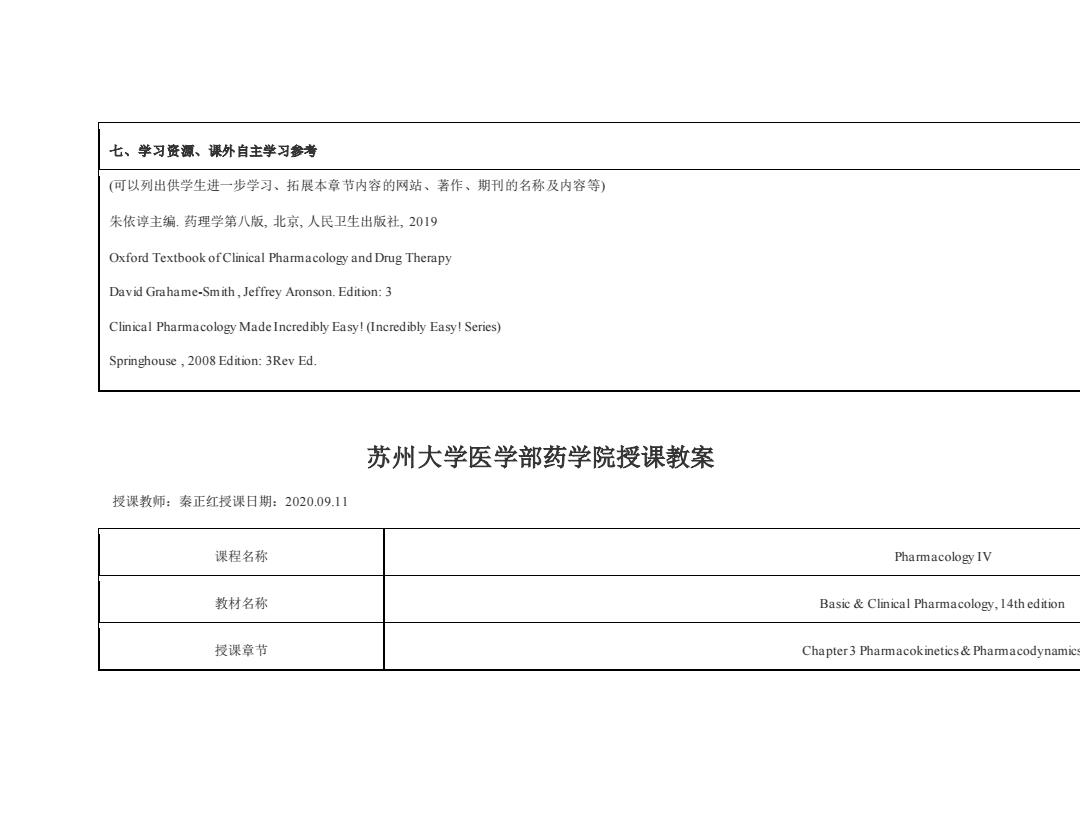
七、学习资源、课外自主学习参考 (可以列出供学生进一步学习、拓展本章节内容的网站、著作、期刊的名称及内容等) 朱依谆主编.药理学第八版,北京,人民卫生出版社,2019 Oxford Textbook of Clinical Pharacology and Drug Therapy David Grahame-Smith,Jeffrey Aronson.Edition:3 Clinical Pharmacology Made Incredibly Easy!(Incredibly Easy!Series) Springhouse,2008 Edition:3Rev Ed. 苏州大学医学部药学院授课教案 授课教师:秦正红授课日期:2020.09.11 课程名称 Pharmacology IV 教材名称 Basic Clinical Pharmacology,14th edition 授课章节 Chapter3 Pharmacokinetics&Phammacodynamics
七、学习资源、课外自主学习参考 (可以列出供学生进一步学习、拓展本章节内容的网站、著作、期刊的名称及内容等) 朱依谆主编. 药理学第八版, 北京, 人民卫生出版社, 2019 Oxford Textbook of Clinical Pharmacology and Drug Therapy David Grahame-Smith , Jeffrey Aronson. Edition: 3 Clinical Pharmacology Made Incredibly Easy! (Incredibly Easy! Series) Springhouse , 2008 Edition: 3Rev Ed. 苏州大学医学部药学院授课教案 授课教师:秦正红授课日期:2020.09.11 课程名称 Pharmacology IV 教材名称 Basic & Clinical Pharmacology, 14th edition 授课章节 Chapter 3 Pharmacokinetics & Pharmacodynamics
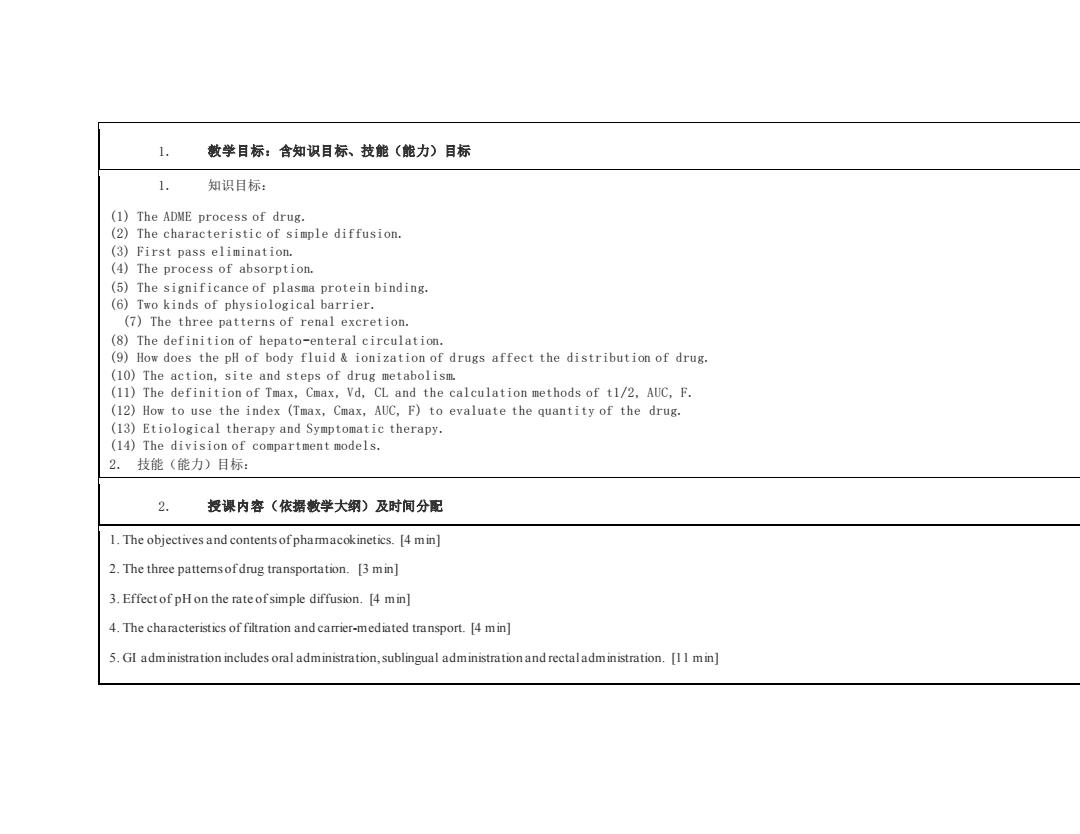
1. 散学目标:含知识目标、技能(能力)目标 1. 知识目标: (1)The ADME process of drug. (2)The characteristic of simple diffusion. (3)First pass elimination. (4)The process of absorption. (5)The significance of plasma protein binding. (6)Two kinds of physiological barrier. (7)The three patterns of renal excretion. (8)The definition of hepato-enteral circulation. (9)How does the pH of body fluid ionization of drugs affect the distribution of drug. (10)The action,site and steps of drug metabolism. (11)The definition of Tmax,Cmax,Vd,CL and the calculation methods of t1/2,AUC,F. (12)How to use the index (Tmax,Cmax,AUC,F)to evaluate the quantity of the drug. (13)Etiological therapy and Symptomatic therapy. (14)The division of compartment models. 2.技能(能力)目标: 2. 授课内容(依据散学大纲)及时间分配 1.The objectives and contents ofpharmacokinetics.[4 min] 2.The three pattemsofdrug transportation.[3 min] 3.Effect of pH on the rate of simple diffusion.[4 min] 4.The characteristics of filtration and carrier-mediated transport.[4 min] 5.GI administration includes oral administration,sublingual administrationand rectaladministration.[II min]
1. 教学目标:含知识目标、技能(能力)目标 1. 知识目标: (1) The ADME process of drug. (2) The characteristic of simple diffusion. (3) First pass elimination. (4) The process of absorption. (5) The significance of plasma protein binding. (6) Two kinds of physiological barrier. (7) The three patterns of renal excretion. (8) The definition of hepato-enteral circulation. (9) How does the pH of body fluid & ionization of drugs affect the distribution of drug. (10) The action, site and steps of drug metabolism. (11) The definition of Tmax, Cmax, Vd, CL and the calculation methods of t1/2, AUC, F. (12) How to use the index (Tmax, Cmax, AUC, F) to evaluate the quantity of the drug. (13) Etiological therapy and Symptomatic therapy. (14) The division of compartment models. 2. 技能(能力)目标: 2. 授课内容(依据教学大纲)及时间分配 1. The objectives and contents of pharmacokinetics. [4 min] 2. The three patterns of drug transportation. [3 min] 3. Effect of pH on the rate of simple diffusion. [4 min] 4. The characteristics of filtration and carrier-mediated transport. [4 min] 5. GI administration includes oral administration, sublingual administration and rectal administration. [11 min]